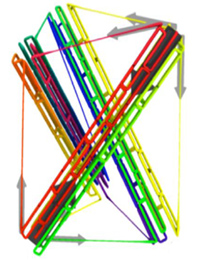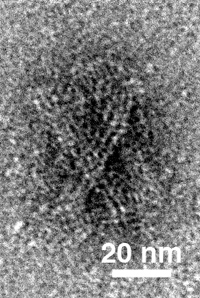Researchers create self-assembling nanodevices that move and change shape on demand
June 23, 2010
Harvard researchers have created nanodevices made of DNA that self-assemble and can be programmed to move and change shape on demand.
The nanodevice structure is based on the principle of tensegrity: its strength and stability results from the way it distributes and balances the counteracting forces of tension and compression.
This new technology could lead to nanoscale medical devices and drug delivery systems, such as virus mimics that introduce drugs directly into diseased cells.
Or it could one day be used to reprogram human stem cells to regenerate different kinds of injured organs and tissue.

A diagrammatic image of a tensegrity built with DNA struts (shown as colored ladders folded into rods) and DNA cable strands (shown as colored single lines). Light gray arrows show contractile forces exerted by the cable strands, while dark gray arrows show compressive forces along the struts. (Tim Liedl)

An electron micrograph of an actual nanoscale tensegrity built using the new DNA-based, self-assembling nanofabrication capabilities. (Tim Liedl)
More info: Harvard Medical School news